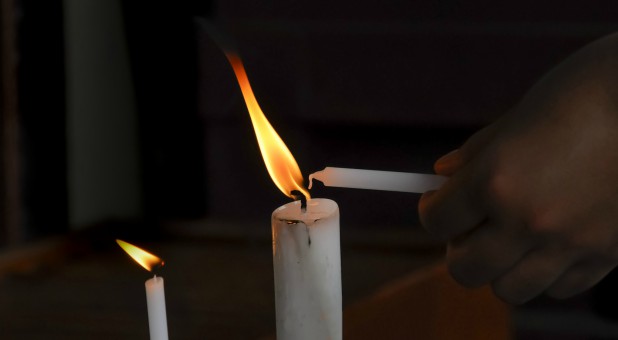Why Hanukkah Is the Prophetic Predecessor of Christmas
The Jewish festival Hanukkah, also known as the Feast of Dedication or the Festival of Lights, has just begun.* After the victory of the Maccabees (from the priestly line of Aaron) over the Syrian Greek army, the eight-day holiday celebrates the rededication of Jerusalem’s holy temple in 164 B.C.
In 167 B.C., the Maccabees rebelled against the Syrian king Antiochus IV, who desecrated the temple in Jerusalem with an altar to the pagan god Zeus and tried forcibly to Hellenize the Jews.
After three to four years of fighting, the Jewish zealots, led by Judah the Maccabee, miraculously experienced victory over the mighty Greek forces and defeated the evil king. They demolished the defiled old altar, built a new one and rededicated the temple. According to the story, they could find only one vessel of sanctified oil, enough for one day of burning candles, yet it somehow lasted eight days. The menorah, or eight-branched candelabrum often associated with Hanukkah, commemorates those miraculous eight days of burning.
The rededication of the temple to the God of Israel is celebrated during Hanukkah, officially established by King Hezekiah (see 2 Chron. 29:17). John’s Gospel also briefly mentions the holiday: “The Feast of the Dedication was at Jerusalem, and it was winter” (John 10:22).
The menorah lighting may well be the most familiar tradition of Hanukkah. Holding nine candles, the central light of the menorah, the shamash, is used to kindle the other eight. During the holiday, the first candle of the eight-branched lamp is lit on the first day; two candles on the second day, and so on until the eighth day when all the candles would be lit. Before the menorah is lit, celebrants often sing special blessings and then traditional songs afterward.
It is also customary to play with a dreidel, a four-sided spinning top bearing the Hebrew letters nun, gimmel, hei and shin, derived from the words nes gadol hayah sham, which translates to “a great miracle happened there.”
Hanukkah celebrations include much feasting as well, with many Jewish households enjoying foods fried in oil, particularly potato pancakes (latkes) and jam-filled donuts (sufganiyot). Other Hanukkah customs include exchanging gifts and rewarding children for positive behavior and devotion to Torah study throughout the year.
Hanukkah then serves as a reminder of a crucial time in history when God saved the Jewish people and their religion from being annihilated by Antiochus. The Lord remained faithful to the Jews, allowing them to defeat the powerful Greeks against all odds.
Had the evil king succeeded, there would have been no Jewish woman named Mary to become the mother of Jesus Christ, the Savior of the world. Hanukkah then celebrates a God capable of doing supernatural things, both in biblical times and right now.
So it’s important for Christians to understand the significance of this holiday, as it prepared the way for the birth and ministry of Jesus and reminds us of God’s faithfulness and power—even in the most impossible situations.
Two thousand years later, the oil of the Holy Spirit has not dried up. The glow of nine candles burning together is far brighter than one. Though we may not fully understand all that God is doing, we know that one day, “All the earth will be filled with the glory of the Lord” (see Num. 14:21, Ps.72:19, Isa. 6:3 and Hab. 2:14).
A Foreshadowing of Christmas
Think of it. The menorah in the Jerusalem temple—holding, bearing the light— so aptly represents Mary, the virgin who bore Jesus. The light, then and now, stands for the light of the world, Jesus Christ. Oil symbolizes the Holy Spirit, a recurring reference in both Old and New Testaments (see 1 Sam. 16:13). The overshadowing power of the Most High God is always the miracle.
“The angel answered her, ‘The Holy Spirit will come upon you, and the power of the Highest will overshadow you. Therefore the Holy One who will be born will be called the Son of God'” (Luke 1:35).
The Jewish people celebrated Hanukkah about 160 years before the birth of Jesus Christ. Knowing how the Old Testament prefigures so much of the truth in the New Testament, it seems an easy conclusion to see “Chanukah” (a more traditional spelling) as a foretelling of the annual Christmas celebration. Interesting also that Chanukah starts on Kislev 25 and Christmas is on Dec. 25. While we know the birth of Jesus Christ really didn’t happen in wintertime, it still seems a divine God-incidence. And how about the fact that Hanukkah celebrations last eight days, the same length of time between Christmas and New Year’s?
Of additional and most significant note, the Hebrew word shamash for the central candle of the menorah—the one which lights all the others—means “servant.” What a bright visual symbol of Jesus, whose bringing the light of salvation to the world we celebrate annually around the very same time.
Jesus said this about himself: “I am the light of the world. Whoever follows me will not walk in darkness, but will have the light of life” (John 8:12).
* This year Hanukkah began on the evening of Dec. 2 and ends at sunset on Dec. 9. According to the Hebrew calendar, it always begins on 25 Kislev, but varies each year on our Gregorian calendar.
This article originally appeared at Bibles for Mideast.
















































